Sajal K. Das
CTG-KrEW: Generating Synthetic Structured Contextually Correlated Content by Conditional Tabular GAN with K-Means Clustering and Efficient Word Embedding
Sep 03, 2024Abstract:Conditional Tabular Generative Adversarial Networks (CTGAN) and their various derivatives are attractive for their ability to efficiently and flexibly create synthetic tabular data, showcasing strong performance and adaptability. However, there are certain critical limitations to such models. The first is their inability to preserve the semantic integrity of contextually correlated words or phrases. For instance, skillset in freelancer profiles is one such attribute where individual skills are semantically interconnected and indicative of specific domain interests or qualifications. The second challenge of traditional approaches is that, when applied to generate contextually correlated tabular content, besides generating semantically shallow content, they consume huge memory resources and CPU time during the training stage. To address these problems, we introduce a novel framework, CTGKrEW (Conditional Tabular GAN with KMeans Clustering and Word Embedding), which is adept at generating realistic synthetic tabular data where attributes are collections of semantically and contextually coherent words. CTGKrEW is trained and evaluated using a dataset from Upwork, a realworld freelancing platform. Comprehensive experiments were conducted to analyze the variability, contextual similarity, frequency distribution, and associativity of the generated data, along with testing the framework's system feasibility. CTGKrEW also takes around 99\% less CPU time and 33\% less memory footprints than the conventional approach. Furthermore, we developed KrEW, a web application to facilitate the generation of realistic data containing skill-related information. This application, available at https://riyasamanta.github.io/krew.html, is freely accessible to both the general public and the research community.
Tackling Selfish Clients in Federated Learning
Jul 22, 2024Abstract:Federated Learning (FL) is a distributed machine learning paradigm facilitating participants to collaboratively train a model without revealing their local data. However, when FL is deployed into the wild, some intelligent clients can deliberately deviate from the standard training process to make the global model inclined toward their local model, thereby prioritizing their local data distribution. We refer to this novel category of misbehaving clients as selfish. In this paper, we propose a Robust aggregation strategy for FL server to mitigate the effect of Selfishness (in short RFL-Self). RFL-Self incorporates an innovative method to recover (or estimate) the true updates of selfish clients from the received ones, leveraging robust statistics (median of norms) of the updates at every round. By including the recovered updates in aggregation, our strategy offers strong robustness against selfishness. Our experimental results, obtained on MNIST and CIFAR-10 datasets, demonstrate that just 2% of clients behaving selfishly can decrease the accuracy by up to 36%, and RFL-Self can mitigate that effect without degrading the global model performance.
Addressing Data Heterogeneity in Federated Learning of Cox Proportional Hazards Models
Jul 20, 2024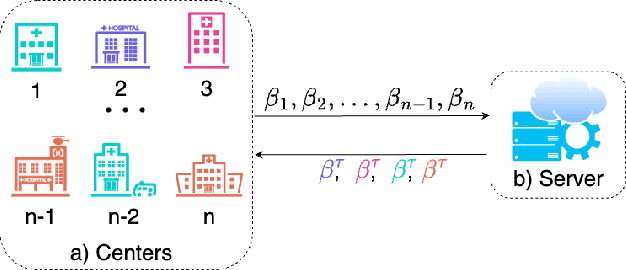
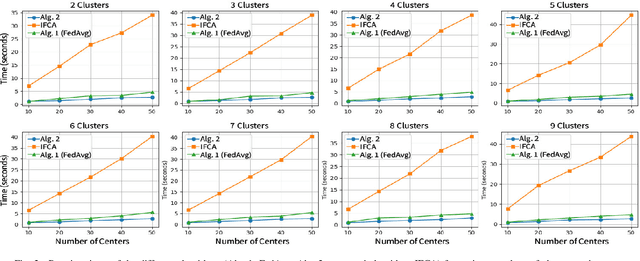
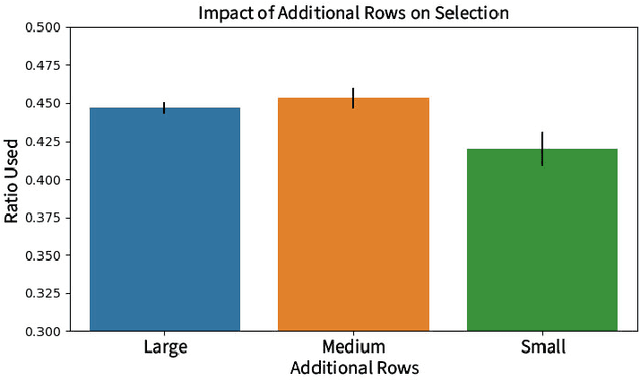
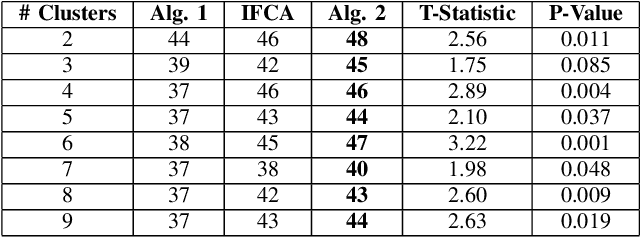
Abstract:The diversity in disease profiles and therapeutic approaches between hospitals and health professionals underscores the need for patient-centric personalized strategies in healthcare. Alongside this, similarities in disease progression across patients can be utilized to improve prediction models in survival analysis. The need for patient privacy and the utility of prediction models can be simultaneously addressed in the framework of Federated Learning (FL). This paper outlines an approach in the domain of federated survival analysis, specifically the Cox Proportional Hazards (CoxPH) model, with a specific focus on mitigating data heterogeneity and elevating model performance. We present an FL approach that employs feature-based clustering to enhance model accuracy across synthetic datasets and real-world applications, including the Surveillance, Epidemiology, and End Results (SEER) database. Furthermore, we consider an event-based reporting strategy that provides a dynamic approach to model adaptation by responding to local data changes. Our experiments show the efficacy of our approach and discuss future directions for a practical application of FL in healthcare.
Using Geographic Location-based Public Health Features in Survival Analysis
Apr 16, 2023Abstract:Time elapsed till an event of interest is often modeled using the survival analysis methodology, which estimates a survival score based on the input features. There is a resurgence of interest in developing more accurate prediction models for time-to-event prediction in personalized healthcare using modern tools such as neural networks. Higher quality features and more frequent observations improve the predictions for a patient, however, the impact of including a patient's geographic location-based public health statistics on individual predictions has not been studied. This paper proposes a complementary improvement to survival analysis models by incorporating public health statistics in the input features. We show that including geographic location-based public health information results in a statistically significant improvement in the concordance index evaluated on the Surveillance, Epidemiology, and End Results (SEER) dataset containing nationwide cancer incidence data. The improvement holds for both the standard Cox proportional hazards model and the state-of-the-art Deep Survival Machines model. Our results indicate the utility of geographic location-based public health features in survival analysis.
Securing Federated Learning against Overwhelming Collusive Attackers
Sep 28, 2022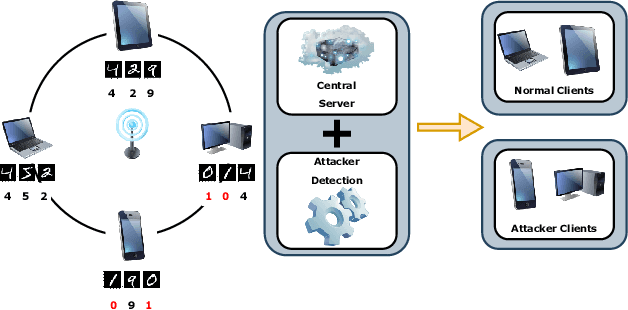
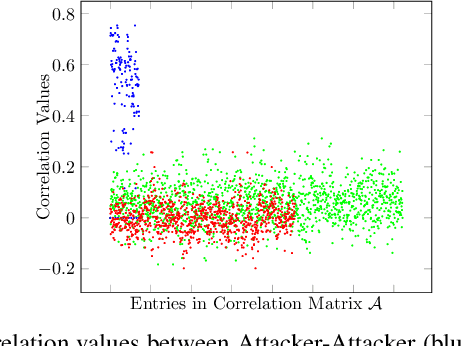
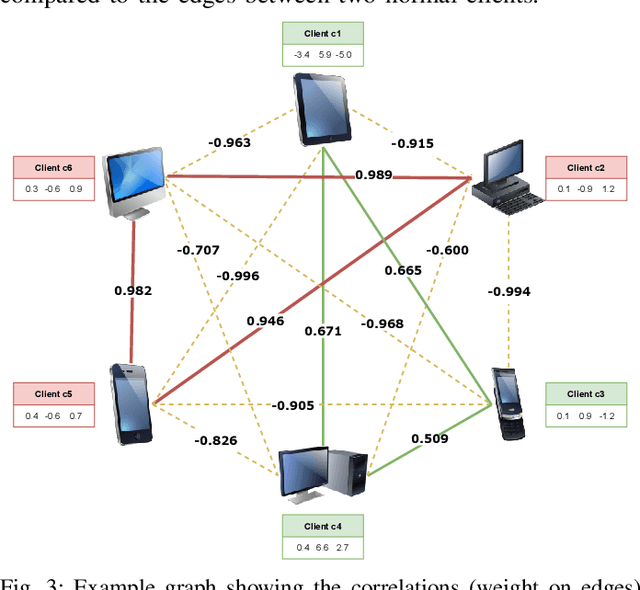
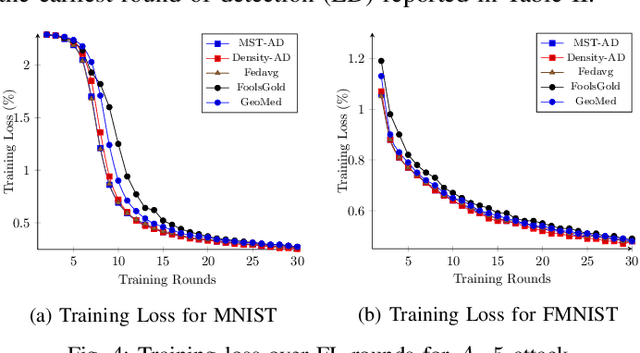
Abstract:In the era of a data-driven society with the ubiquity of Internet of Things (IoT) devices storing large amounts of data localized at different places, distributed learning has gained a lot of traction, however, assuming independent and identically distributed data (iid) across the devices. While relaxing this assumption that anyway does not hold in reality due to the heterogeneous nature of devices, federated learning (FL) has emerged as a privacy-preserving solution to train a collaborative model over non-iid data distributed across a massive number of devices. However, the appearance of malicious devices (attackers), who intend to corrupt the FL model, is inevitable due to unrestricted participation. In this work, we aim to identify such attackers and mitigate their impact on the model, essentially under a setting of bidirectional label flipping attacks with collusion. We propose two graph theoretic algorithms, based on Minimum Spanning Tree and k-Densest graph, by leveraging correlations between local models. Our FL model can nullify the influence of attackers even when they are up to 70% of all the clients whereas prior works could not afford more than 50% of clients as attackers. The effectiveness of our algorithms is ascertained through experiments on two benchmark datasets, namely MNIST and Fashion-MNIST, with overwhelming attackers. We establish the superiority of our algorithms over the existing ones using accuracy, attack success rate, and early detection round.
Suppressing Noise from Built Environment Datasets to Reduce Communication Rounds for Convergence of Federated Learning
Sep 03, 2022



Abstract:Smart sensing provides an easier and convenient data-driven mechanism for monitoring and control in the built environment. Data generated in the built environment are privacy sensitive and limited. Federated learning is an emerging paradigm that provides privacy-preserving collaboration among multiple participants for model training without sharing private and limited data. The noisy labels in the datasets of the participants degrade the performance and increase the number of communication rounds for convergence of federated learning. Such large communication rounds require more time and energy to train the model. In this paper, we propose a federated learning approach to suppress the unequal distribution of the noisy labels in the dataset of each participant. The approach first estimates the noise ratio of the dataset for each participant and normalizes the noise ratio using the server dataset. The proposed approach can handle bias in the server dataset and minimizes its impact on the participants' dataset. Next, we calculate the optimal weighted contributions of the participants using the normalized noise ratio and influence of each participant. We further derive the expression to estimate the number of communication rounds required for the convergence of the proposed approach. Finally, experimental results demonstrate the effectiveness of the proposed approach over existing techniques in terms of the communication rounds and achieved performance in the built environment.
FedAR+: A Federated Learning Approach to Appliance Recognition with Mislabeled Data in Residential Buildings
Sep 03, 2022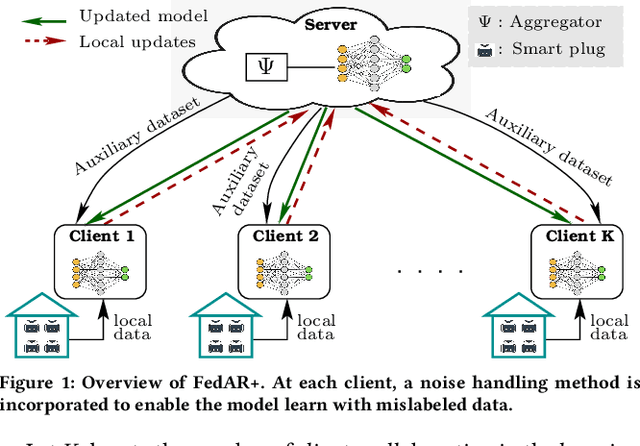
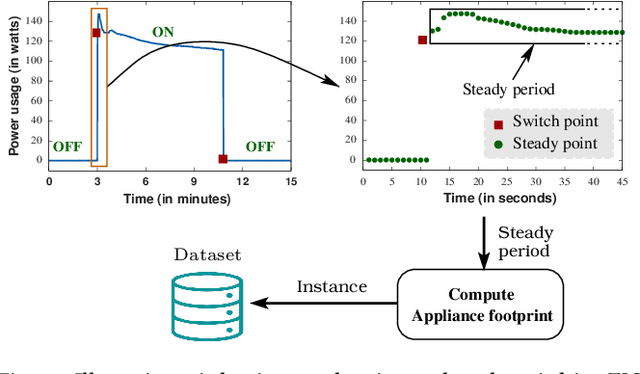
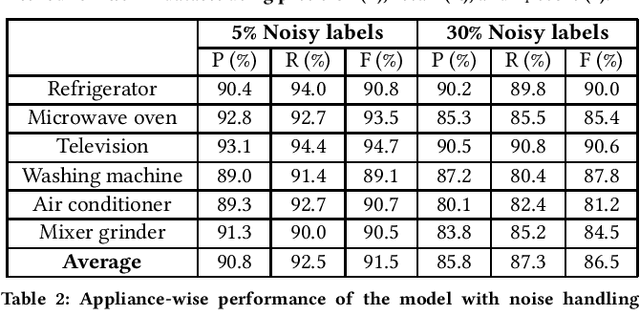
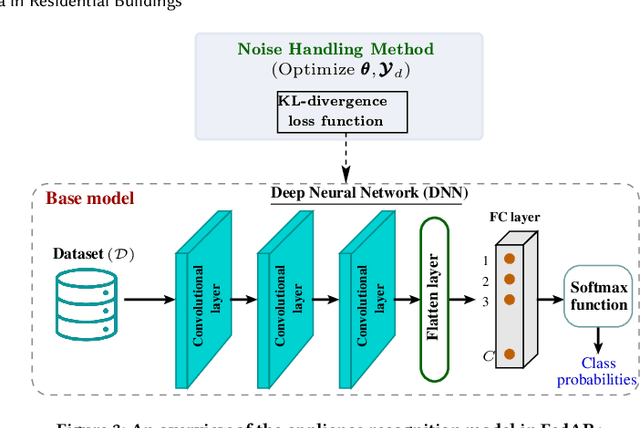
Abstract:With the enhancement of people's living standards and rapid growth of communication technologies, residential environments are becoming smart and well-connected, increasing overall energy consumption substantially. As household appliances are the primary energy consumers, their recognition becomes crucial to avoid unattended usage, thereby conserving energy and making smart environments more sustainable. An appliance recognition model is traditionally trained at a central server (service provider) by collecting electricity consumption data, recorded via smart plugs, from the clients (consumers), causing a privacy breach. Besides that, the data are susceptible to noisy labels that may appear when an appliance gets connected to a non-designated smart plug. While addressing these issues jointly, we propose a novel federated learning approach to appliance recognition, called FedAR+, enabling decentralized model training across clients in a privacy preserving way even with mislabeled training data. FedAR+ introduces an adaptive noise handling method, essentially a joint loss function incorporating weights and label distribution, to empower the appliance recognition model against noisy labels. By deploying smart plugs in an apartment complex, we collect a labeled dataset that, along with two existing datasets, are utilized to evaluate the performance of FedAR+. Experimental results show that our approach can effectively handle up to $30\%$ concentration of noisy labels while outperforming the prior solutions by a large margin on accuracy.
Long-Short History of Gradients is All You Need: Detecting Malicious and Unreliable Clients in Federated Learning
Aug 14, 2022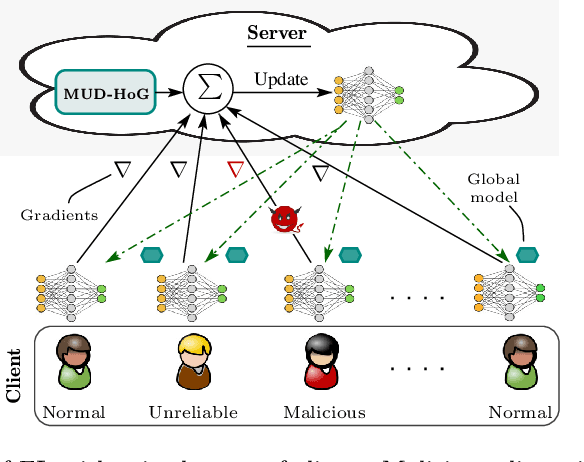
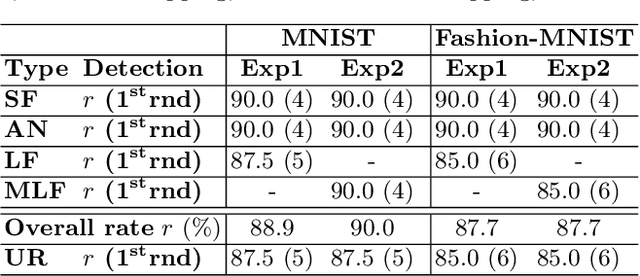
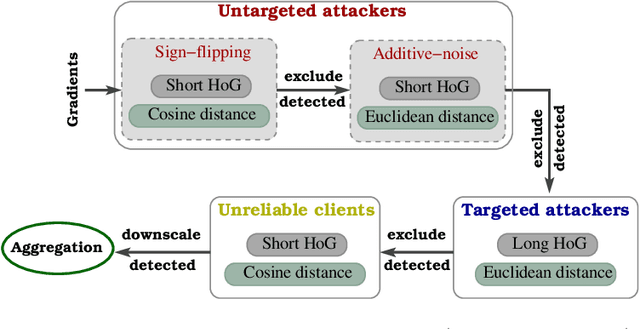
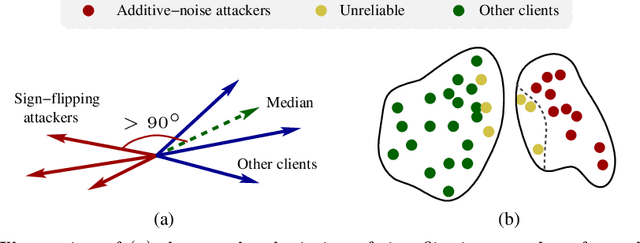
Abstract:Federated learning offers a framework of training a machine learning model in a distributed fashion while preserving privacy of the participants. As the server cannot govern the clients' actions, nefarious clients may attack the global model by sending malicious local gradients. In the meantime, there could also be unreliable clients who are benign but each has a portion of low-quality training data (e.g., blur or low-resolution images), thus may appearing similar as malicious clients. Therefore, a defense mechanism will need to perform a three-fold differentiation which is much more challenging than the conventional (two-fold) case. This paper introduces MUD-HoG, a novel defense algorithm that addresses this challenge in federated learning using long-short history of gradients, and treats the detected malicious and unreliable clients differently. Not only this, but we can also distinguish between targeted and untargeted attacks among malicious clients, unlike most prior works which only consider one type of the attacks. Specifically, we take into account sign-flipping, additive-noise, label-flipping, and multi-label-flipping attacks, under a non-IID setting. We evaluate MUD-HoG with six state-of-the-art methods on two datasets. The results show that MUD-HoG outperforms all of them in terms of accuracy as well as precision and recall, in the presence of a mixture of multiple (four) types of attackers as well as unreliable clients. Moreover, unlike most prior works which can only tolerate a low population of harmful users, MUD-HoG can work with and successfully detect a wide range of malicious and unreliable clients - up to 47.5% and 10%, respectively, of the total population. Our code is open-sourced at https://github.com/LabSAINT/MUD-HoG_Federated_Learning.
Single Image Internal Distribution Measurement Using Non-Local Variational Autoencoder
Apr 02, 2022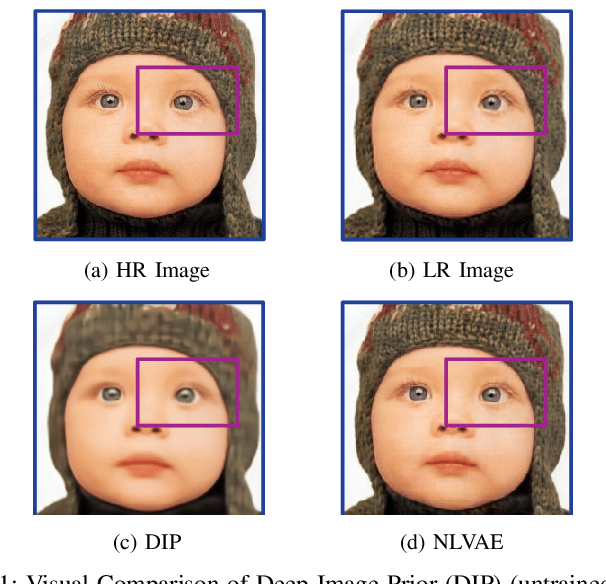
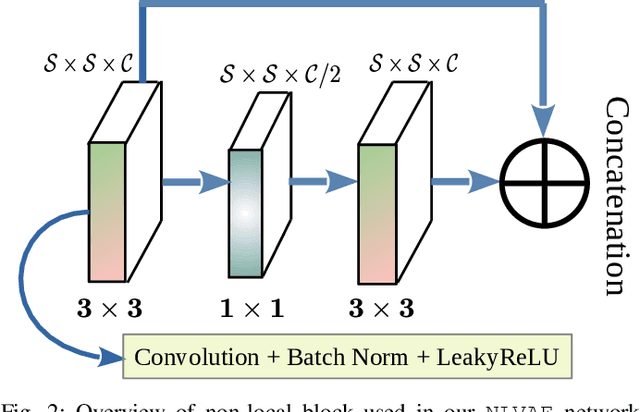
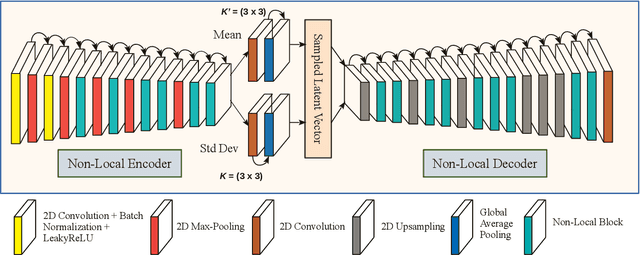
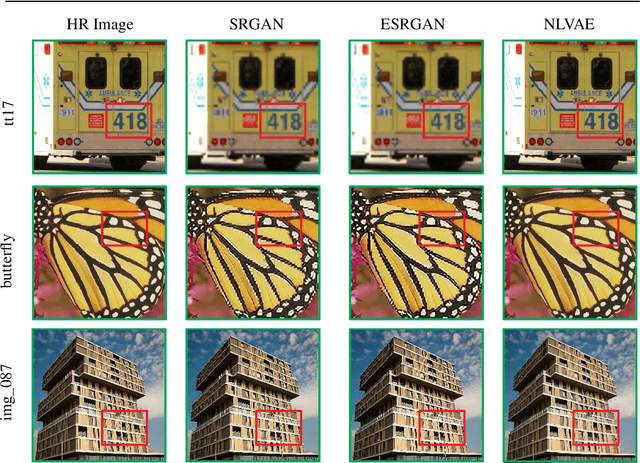
Abstract:Deep learning-based super-resolution methods have shown great promise, especially for single image super-resolution (SISR) tasks. Despite the performance gain, these methods are limited due to their reliance on copious data for model training. In addition, supervised SISR solutions rely on local neighbourhood information focusing only on the feature learning processes for the reconstruction of low-dimensional images. Moreover, they fail to capitalize on global context due to their constrained receptive field. To combat these challenges, this paper proposes a novel image-specific solution, namely non-local variational autoencoder (\texttt{NLVAE}), to reconstruct a high-resolution (HR) image from a single low-resolution (LR) image without the need for any prior training. To harvest maximum details for various receptive regions and high-quality synthetic images, \texttt{NLVAE} is introduced as a self-supervised strategy that reconstructs high-resolution images using disentangled information from the non-local neighbourhood. Experimental results from seven benchmark datasets demonstrate the effectiveness of the \texttt{NLVAE} model. Moreover, our proposed model outperforms a number of baseline and state-of-the-art methods as confirmed through extensive qualitative and quantitative evaluations.
On the Robot Assisted Movement in Wireless Mobile Sensor Networks
Jul 07, 2021



Abstract:This paper deals with random sensors initially randomly deployed on the line according to general random process and on the plane according to two independent general random processes. The mobile robot with carrying capacity $k$ placed at the origin point is to move the sensors to achieve the general scheduling requirement such as coverage, connectivity and thus to satisfy the desired communication property in the network. We study tradeoffs between the energy consumption in robot's movement, the numbers of sensors $n$, the sensor range $r$, the interference distance $s$, and the robot capacity $k$ until completion of the coverage simultaneously with interference scheduling task. In this work, we obtain upper bounds for the energy consumption in robot's movement and obtain the sharp decrease in the total movement cost of the robot so as to provide the coverage simultaneously with interference requirement.
 Add to Chrome
Add to Chrome Add to Firefox
Add to Firefox Add to Edge
Add to Edge